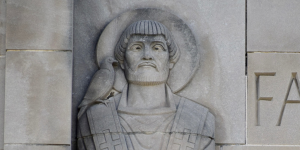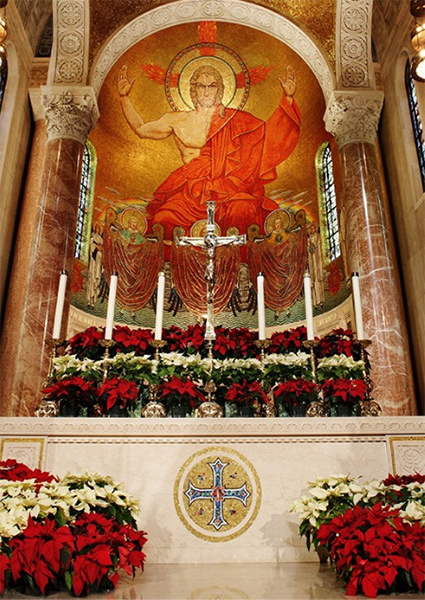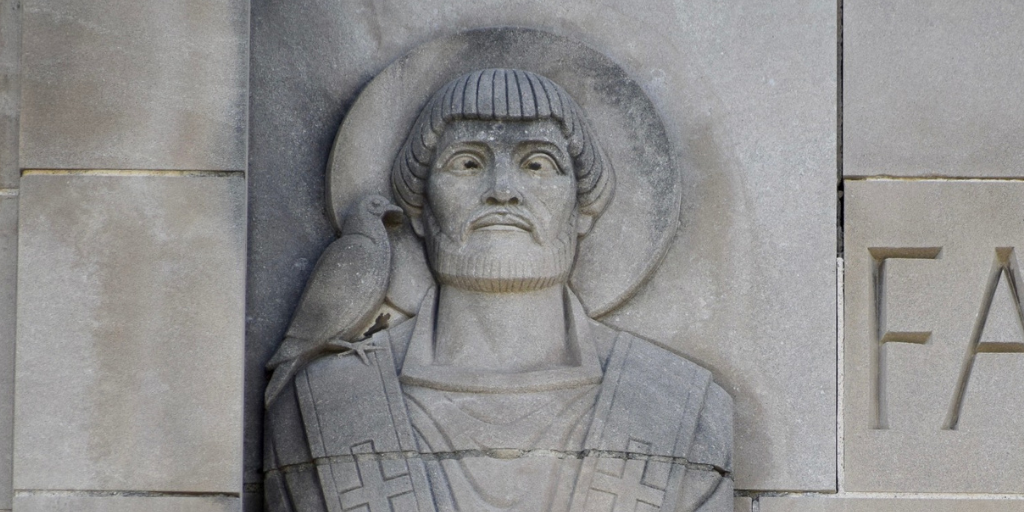
In this second post in our Doctors of the Church series, we invite you to learn about three early Doctors of the Church and their contributions to the faith. From Saint Basil, who bravely fought against Arianism, to Saint Ambrose, who resisted authoritarianism, each of these men helped shape the doctrine of the early Church and draw others closer to the truth of the Gospel.
Read Part I of the Doctors of the Church series.
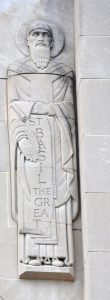
Saint Basil the Great, 329-379 A.D.
Born in 329 in Caesarea, St. Basil lived when disagreements about Arianism were pervasive and divisive. Arius, a citizen of Alexandria, thought that Christ was created by the Father and was not fully God, and many began to follow his teachings. In response, the Church developed the Nicene Creed. Basil was influential in fighting the Arian heresy, writing many works to support the Church’s stance.
One of 10 children in a Christian family, Basil was baptized into the Church at age 29. In the years that followed, he lived as a hermit and eventually became archbishop of Caesarea. But his opposition to Arianism resulted in challenges to his authority even from the secular world; at one point, the Arian emperor Valens split Basil’s region into two dioceses to undermine his authority.
Despite the opposition he faced, Basil led with compassion, distinguishing himself as a moving orator and writer, and directing his attention both to the spiritual and temporal needs of his region. He preached as often as twice a day, cared for the needy, provided support during a famine, fought prostitution, and even built a hospital. He was also a prolific writer, penning many letters and books to defend the Church’s doctrine. You can find him portrayed in the East Portico of the Basilica.
Saint Gregory of Nazianzus, c. 325-390 A.D.
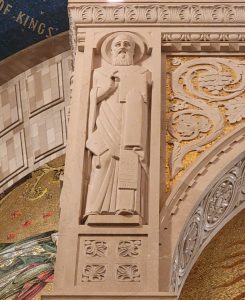
Born around the year 325, Saint Gregory passionately defended the doctrine of the Trinity during a critical period for the Church. Called “The Theologian” by historians, Gregory was baptized at age 30 and studied with his brother in Caesarea, where he met Saint Basil. At the time, Basil was just a fellow student, but the two would grow to be dear friends.
Over the years, Gregory assisted Basil in a number of efforts, including his battles against Arianism and his clashes with the Arian Emperor Valens. Unfortunately, Gregory’s desire to help Basil would ultimately culminate in the breaking of their friendship. When Basil established a See at Sasima, he consecrated a reluctant Gregory as its first bishop. But Gregory soon found himself as ill-suited to the position as he had predicted and left to serve his father in Nazianzus.
Following the death of Emperor Valens, Arianism no longer received imperial support, leaving greater opportunity for combatting the heresy. Despite his reservations, Gregory went to restore truth in the city of Constantinople in 379, preaching on the doctrine of the Trinity at his Chapel of the Resurrection (the Anastasia). These profound sermons would eventually become some of his most well-known works. Eventually, he returned home to Nazianzen, where he lived peacefully, composing many poems in the final years of his life. You can find him portrayed in the Basilica in the Baldachin.
Saint Ambrose, 340-397 A.D.
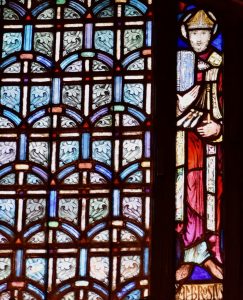
Born around the year 340, Ambrose was the son of a high-ranking government official in Rome. Though his career began on a political trajectory, with a tenure as governor of northern Italy, the most pivotal moment in Ambrose’ life happened after the death of the bishop of Milan. The region was fraught with unrest as they argued over who should be the next bishop. Amidst the chaos, Ambrose urged the people to be peaceful and judicious in their selection. His sensibility gained him support, and within a week, he was baptized and consecrated bishop of Milan, even though he didn’t want the position!
Though he had previously lived a secular life, Ambrose poured himself into religious life following his appointment, studying Scripture and theology and praying daily. As he shepherded the Church through a tumultuous era, he shaped key areas of Christian doctrine and fearlessly stood against secular excesses in authority.
Over the course of his life, Ambrose penned many essays on asceticism, theology, spirituality, and contemporary issues of the era. He is also believed to have been influential in St. Augustine’s conversion to Christ, baptizing him in 387. Ambrose is the patron of beekeepers, learners, and Milan, and is depicted in the Basilica in the East Portico, the Baldachin, and in a window in the St. Margaret of Antioch chapel.
Sources:
Butler’s Lives of Saints, ed. Bernard Bangley.
Rohling, Geraldine M., PhD, MAEd. The Basilica of the National Shrine of the Immaculate Conception: Guide and Tour Book. Washington, D.C.: Basilica of the National Shrine of the Immaculate Conception, 2018.
“Saint Gregory Nazianzen,” Franciscan Media.
“St. Gregory of Nazianzus,” Britannica.
“St. Gregory Nazianzen,” CNA.
“St. Gregory of Nazianzus,” New Advent.
The Way of Saints, Dr. Tom Cowan.

